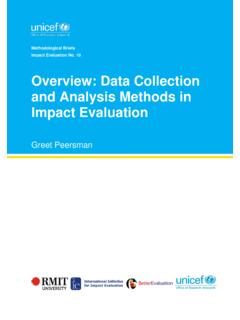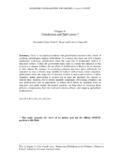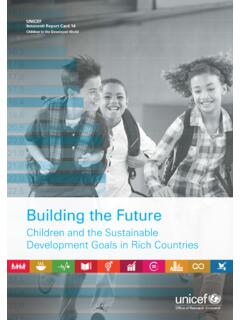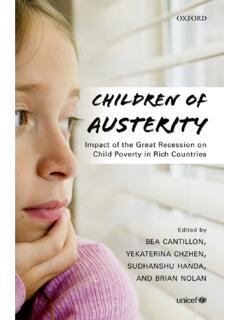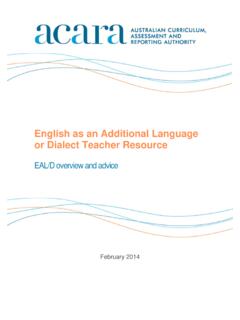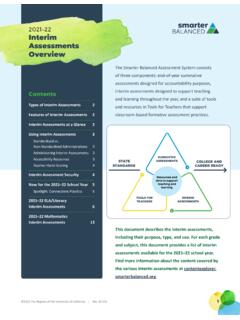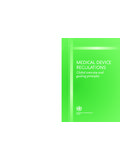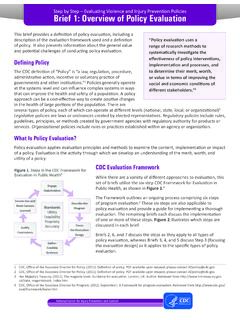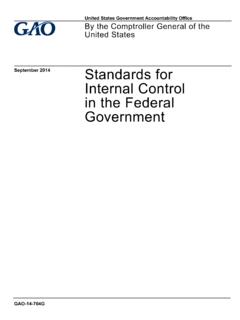Transcription of Overview of Impact Evaluation - unicef-irc.org
1 Methodological Briefs Impact Evaluation No. 1 Overview of Impact Evaluation Patricia Rogers UNICEF OFFICE OF RESEARCH The Office of Research is UNICEF s dedicated research arm. Its prime objectives are to improve international understanding of issues relating to children s rights and to help facilitate full implementation of the Convention on the Rights of the Child across the world. The Office of Research aims to set out a comprehensive framework for research and knowledge within the organization, in support of UNICEF s global programmes and policies, and works with partners to make policies for children evidence-based. Publications produced by the Office are contributions to a global debate on children and child rights issues and include a wide range of opinions. The views expressed are those of the authors and/or editors and are published in order to stimulate further dialogue on Impact Evaluation methods.
2 They do not necessarily reflect the policies or views of UNICEF. OFFICE OF RESEARCH METHODOLOGICAL BRIEFS UNICEF Office of Research Methodological Briefs are intended to share contemporary research practice, methods, designs, and recommendations from renowned researchers and evaluators. The primary audience is UNICEF staff who conduct, commission or interpret research and Evaluation findings to make decisions about programming, policy and advocacy. This brief has undergone an internal peer review. The text has not been edited to official publication standards and UNICEF accepts no responsibility for errors. Extracts from this publication may be freely reproduced with due acknowledgement. Requests to utilize larger portions or the full publication should be addressed to the Communication Unit at To consult and download the Methodological Briefs, please visit For readers wishing to cite this document we suggest the following form: Rogers, P.
3 (2014). Overview of Impact Evaluation , Methodological Briefs: Impact Evaluation 1, UNICEF Office of Research, Florence. Acknowledgements: This brief benefited from the guidance of many individuals. The author and the Office of Research wish to thank everyone who contributed and in particular the following: Contributors: Simon Hearn, Jessica Sinclair Taylor, Howard White Reviewers: Nikola Balvin, Samuel Bickel, Christian Salazar, David Stewart 2014 United Nations Children s Fund (UNICEF) September 2014 UNICEF Office of Research - Innocenti Piazza SS. Annunziata, 12 50122 Florence, Italy Tel: (+39) 055 20 330 Fax: (+39) 055 2033 220 Methodological Brief : Overview of Impact Evaluation Page 1 1. WHAT IS Impact Evaluation - AND WHY DOES IT MATTER? Impact evaluations provide information about the impacts produced by an intervention.
4 Impact Evaluation can be undertaken of a programme or a policy, or upstream work such as capacity building, policy advocacy and support for an enabling environment. This goes beyond looking only at goals and objectives to also examine unintended impacts. OEDC-DAC defines impacts as positive and negative, primary and secondary long-term effects produced by a development intervention, directly or indirectly, intended or unintended. 1 An Impact Evaluation can be undertaken for formative purposes (to improve or reorient a programme or policy) or for summative purposes (to inform decisions about whether to continue, discontinue, replicate or scale up a programme or policy). It can be used by UNICEF and its partners at the global, regional or country level to inform decisions and for advocacy and advice. This brief provides an Overview of the different elements of Impact Evaluation and the different options for UNICEF programme managers for each of these elements, in terms of stages involved in planning and managing an Impact Evaluation .
5 These stages are as follows, although these can sometimes vary in order or may be revisited: deciding to conduct an Impact Evaluation establishing governance and management arrangements preparing for the Impact Evaluation developing a Terms of Reference (ToR) for the Evaluation engaging the Evaluation team overseeing the Evaluation , including the production of Evaluation reports following up the Evaluation . Guidance is also provided on addressing ethical issues and ensuring quality during an Impact Evaluation . This brief is an introduction to a UNICEF series of methodological briefs, which provides more detailed guidance on the core building blocks of Impact Evaluation (theory of change, evaluative criteria and evaluative reasoning), different Evaluation designs and methods for data collection and analysis, and options in terms of participatory approaches.
6 2. DECIDING TO CONDUCT AN Impact Evaluation It is important that Impact Evaluation is addressed as part of an integrated monitoring, Evaluation and research plan (IMERP) that generates and makes available evidence to inform decisions. This will ensure that data from other monitoring and Evaluation components such as performance monitoring and process Evaluation can be used as needed. It will also ensure that planning for an Impact Evaluation begins early, allowing for the collection of baseline data and, where appropriate, the creation of a control group or comparison group or the use of other strategies to investigate causal attribution. 1 OEDC-DAC, glossary of Key Terms in Evaluation and Results Based Management, OEDC, Paris, 2010. See Methodological Brief : Overview of Impact Evaluation Page 2 An Impact Evaluation should only be undertaken when its intended use can be clearly identified and when it is likely to be able to produce useful findings, taking into account the availability of resources and the timing of decisions about the programme or policy under investigation.
7 A formal evaluability assessment (EA)2 might first need to be conducted to assess these aspects. Formative Impact evaluations are undertaken to inform decisions in regard to making changes to a programme or policy. While many formative evaluations focus on processes, Impact evaluations can be used formatively if an intervention is ongoing. For example, the findings of an Impact Evaluation can be used to improve implementation of a programme for the next intake of participants. Summative Impact evaluations are undertaken to inform decisions about whether to continue, discontinue, replicate or scale up an intervention. Ideally, a summative Impact Evaluation not only produces findings about what works but also provides information about what is needed to make the intervention work for different groups in different settings, which can then be used to inform decisions.
8 When an Impact Evaluation might be appropriate Table Impact Evaluation might be appropriate Impact Evaluation might not be appropriate Intended uses and timing There is scope to use the findings to inform decisions about future programmes or policies. There are no clear intended uses or intended users for example, decisions have already been made on the basis of existing credible evidence, or need to be made before it will be possible to undertake a credible Impact Evaluation . Focus There is a need to understand the impacts that have been produced. The priority at this stage is to understand and improve the quality of implementation. Resources There are adequate resources to undertake a sufficiently comprehensive and rigorous Impact Evaluation , including the availability of existing, good quality data and additional time and money to collect more.
9 Existing data are inadequate and there are insufficient resources to fill gaps. Relevance It is clearly linked to national and UNICEF strategies and priorities. It is peripheral to national and UNICEF strategies and priorities. The process of prioritizing interventions to undergo Impact Evaluation should involve a range of stakeholders, including government representatives, civil society, UN system managers and officers, and representatives of other partner organizations. The process should consider the relevance of the Evaluation in terms of national and UN strategies, its potential usefulness and commitment to its use by senior managers, its potential use for advocacy for evidence-based policy, and accountability 2 For more information, see: BetterEvaluation, Evaluability Assessment , web page, BetterEvaluation, 3 For further advice, see: United Nations Children s Fund, Revised Evaluation Policy, E7 ICEF72013/14, Executive Board Annual Session 18 21 June 2013, UNICEF, 2013.
10 Methodological Brief : Overview of Impact Evaluation Page 3 It is also important to consider when it is appropriate to conduct an Impact Evaluation . Impact evaluations that are conducted belatedly will provide information too late to inform decisions. For this reason, some reports that are labelled Impact evaluations actually only report on intermediate outcomes that are evident during the life of the Evaluation rather than on the long-term impacts of the intervention. For example, the Evaluation of Mexico s Progresa/Oportunidades conditional cash transfer (CCT) programme4 looked at school attendance rates rather than learning outcomes. But Impact evaluations that are done too early will provide an inaccurate picture of the impacts. In some cases, impacts will be understated, as these will not have had sufficient time to develop, for example, children completing school after participating in an early intervention programme.

